The Email Marketing Strategy That Makes DigitalMarketer $39M+ Sales Year Over Year

We send emails because that’s how we engage with our audience, that’s how we segment people by interest and figure out what our subscribers need the most in their business. If we don’t help businesses grow, then we fail,” – Richard LindnerIf you know a thing or two about email marketing, you know the above statement is the backbone of a successful email marketing strategy. So, it’s no wonder that DigitalMarketer nails email marketing. DigitalMarketer is one of the top-performing marketing education companies on the web. They have an exceptional view of email marketing, which is one of the main reasons they perform so well. But all this would be just empty statements. So let's take a look at some statistics that paint a clear picture of DigitalMarketer’s email marketing efforts. DigitalMarketer was created in 2011, and as of 2015, here’s how the company was doing:
- Billions of emails sent in multiple markets.
- Hundreds of (successful) strategies created and implemented.
- Tripled open rates and doubled click-through rates.
- Generated over $20M+ in revenue in that year from email marketing alone.
 Here’s another proof that email marketing is a big part of DigitalMarketer’s sales. Digitalmarketer.com gets 8.76% of its overall traffic from email–about 36,000 visitors per month.
Here’s another proof that email marketing is a big part of DigitalMarketer’s sales. Digitalmarketer.com gets 8.76% of its overall traffic from email–about 36,000 visitors per month.
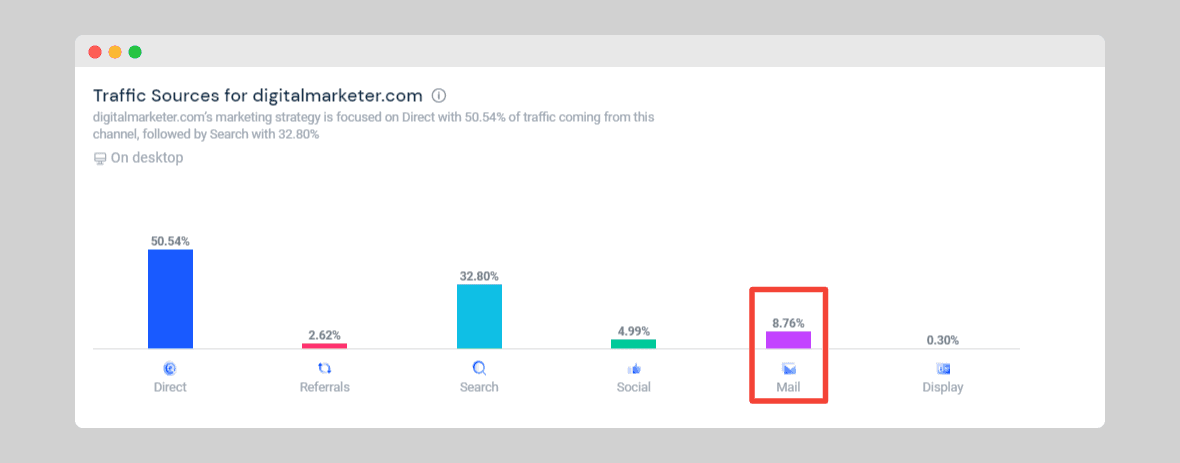 DigitalMarketer owes this success to a set of email marketing tactics that use psychological and marketing techniques that have proven effective over time.
In this article, you’ll learn everything about the email marketing tactics behind DigitalMarketer’s success.
DigitalMarketer owes this success to a set of email marketing tactics that use psychological and marketing techniques that have proven effective over time.
In this article, you’ll learn everything about the email marketing tactics behind DigitalMarketer’s success.
The Email Marketing Strategy That Makes DigitalMarketer $39M+ Sales Year Over Year via @CoSchedule
Click To TweetDownload Your Email Marketing Strategy Template
Want to document your own email marketing strategy like the one DigitalMarketer used to drive incredible growth? Download this actionable template now, then continue reading to get the knowledge you need to succeed:- The Lead Magnet-Type That Grows Your Email List Fast
- The 4-Step Welcome Sequence That Turns Subscribers Into Buyers
- The Types Of Subject Lines DigitalMarketer Uses to Make Over 39M In Sales
- The 2 Types Of Copywriting Formulas To Boost Your Clickthrough And Conversion Rates
- The Segmentation Tactic That Keep Campaigns Successful
The Lead Magnet-Type That Grows Your Email List Fast
Unarguably, there’s no email marketing without an email list. And as Noah Kagan likes to say, “The money is in the list.” DigitalMaketer understands this very well. And so, the first move on their marketing chessboard aims towards building an email list. They employ a lead magnet design tactic to collect email addresses from their visitors. The company was able to collect 35,859 leads in 60 days using one lead magnet. Here is how they’ve done it.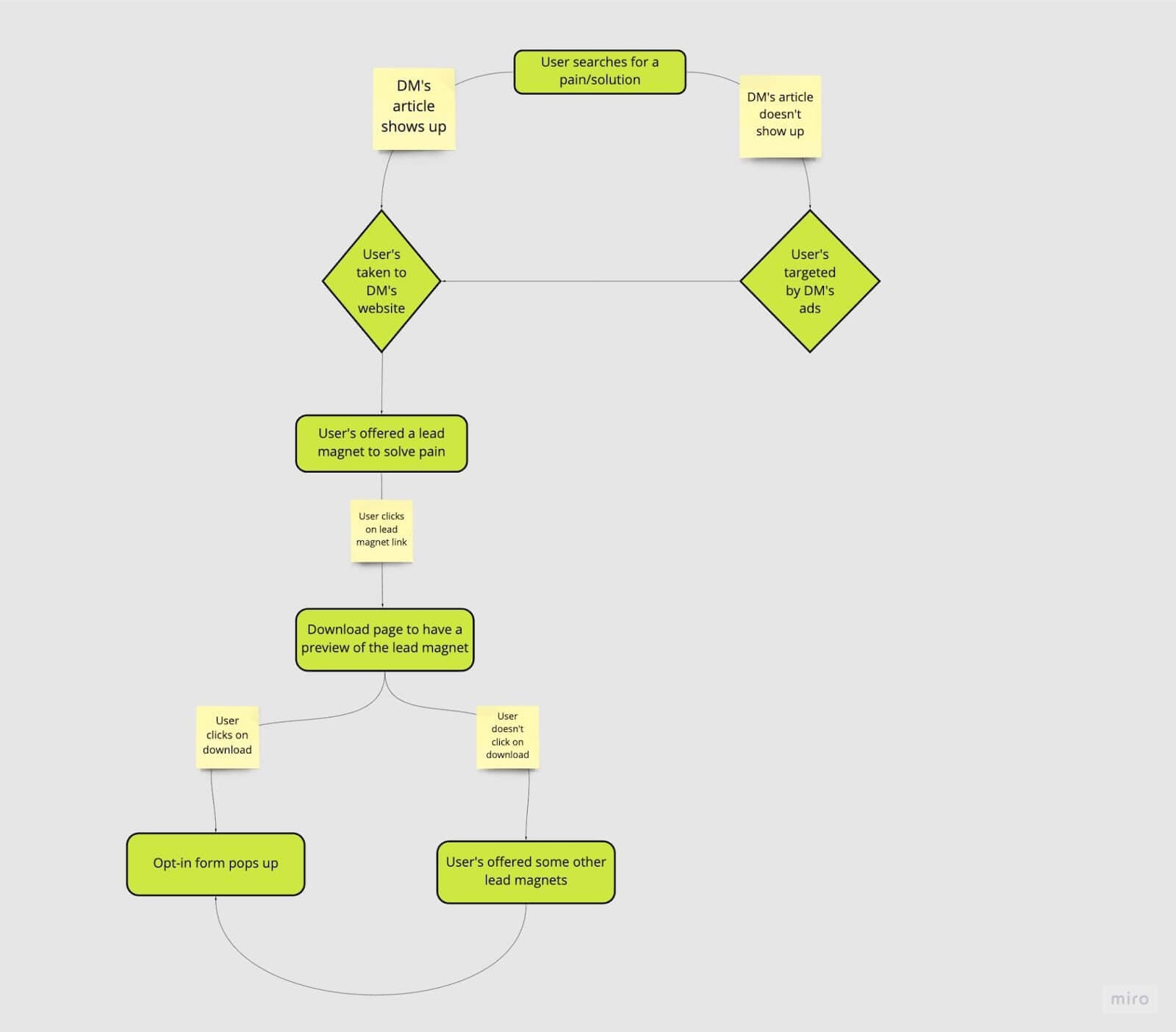 First, they employ the Pain-Point SEO strategy to create blog articles that solve specific problems. These are generally how-to, what-is, and “example” articles.
First, they employ the Pain-Point SEO strategy to create blog articles that solve specific problems. These are generally how-to, what-is, and “example” articles.
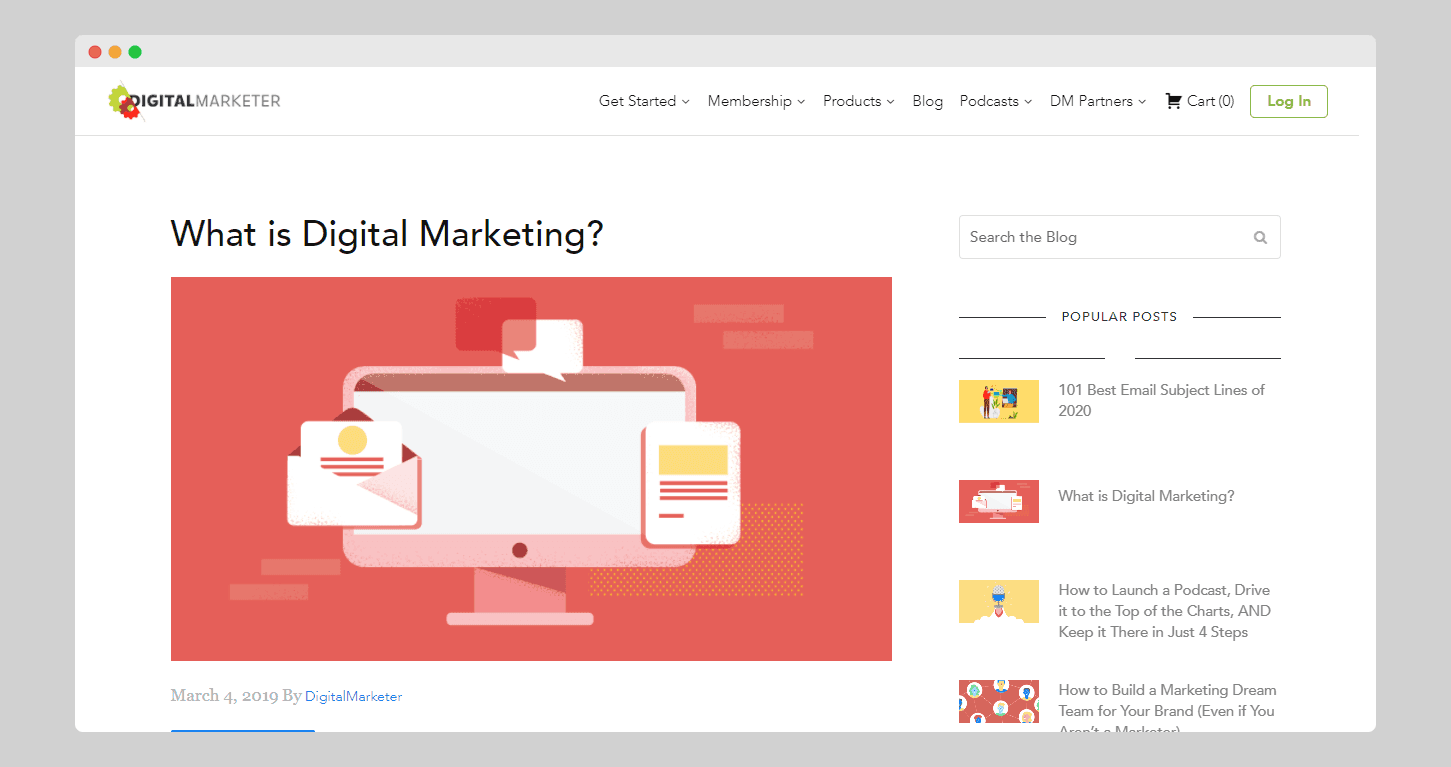 Then, they place the lead magnet in articles with huge traffic potential first, just like below.
Then, they place the lead magnet in articles with huge traffic potential first, just like below.
 This is powerful because these are the types of articles that quickly provide the answers visitors seek. Therefore, they generate massive traffic.
As you can see, these articles agitate the readers’ problems and provide tailored information, and that's where DigitalMarketer brings lead magnets to the table.
But that’s not all.
Before placing the lead magnet in the high-traffic article, the marketing team at DigitalMarketer makes sure its positioning is on point.
What does that entail?
For a visitor reading an article about digital marketing, DigitalMarketer presents a lead magnet that embodies digital marketing strategies. The trick is to make the topic and content of the lead magnet naturally mesh seamlessly.
Then, the company uses clever positioning within the article to make the lead magnet relevant to the reading context and ensure it's not dull or obnoxious.
Here is how.
This is powerful because these are the types of articles that quickly provide the answers visitors seek. Therefore, they generate massive traffic.
As you can see, these articles agitate the readers’ problems and provide tailored information, and that's where DigitalMarketer brings lead magnets to the table.
But that’s not all.
Before placing the lead magnet in the high-traffic article, the marketing team at DigitalMarketer makes sure its positioning is on point.
What does that entail?
For a visitor reading an article about digital marketing, DigitalMarketer presents a lead magnet that embodies digital marketing strategies. The trick is to make the topic and content of the lead magnet naturally mesh seamlessly.
Then, the company uses clever positioning within the article to make the lead magnet relevant to the reading context and ensure it's not dull or obnoxious.
Here is how.
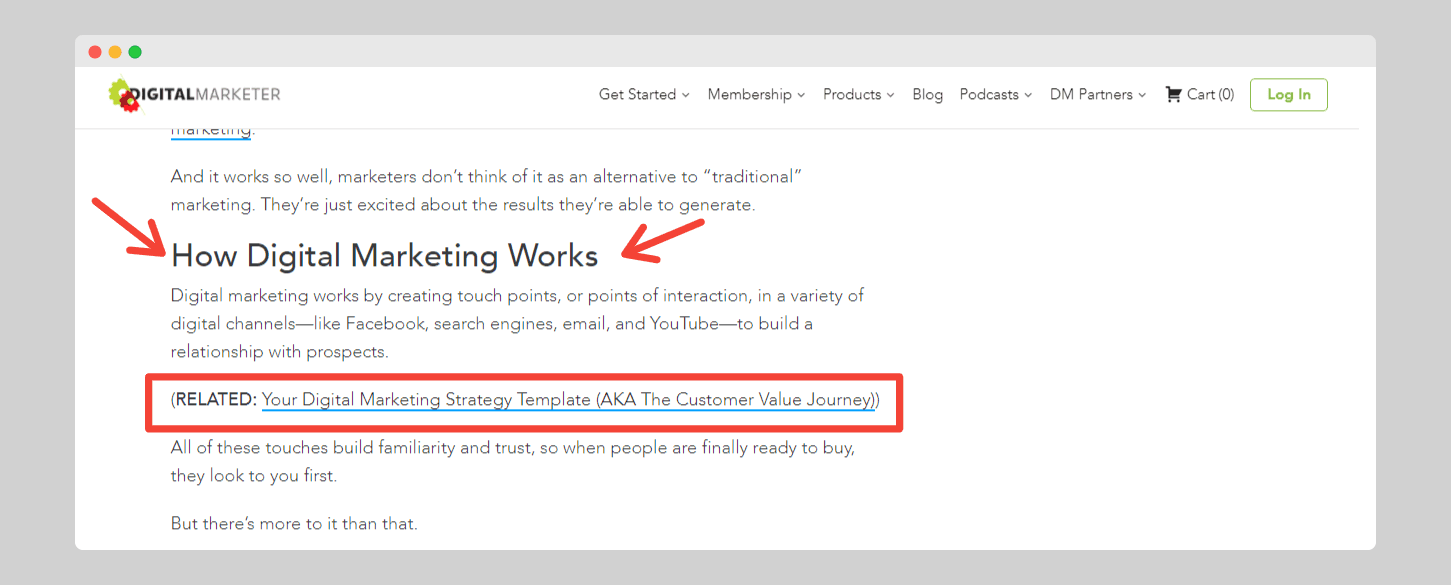 In our example case, DigitalMarketer's lead magnet does not appear at the beginning or pops up anywhere inside the article. Instead, they position the lead magnet (Digital marketing Strategy Template) in the "How Digital Marketing Works" section.
Think of it like a visitor reading a recipe for cooking their favorite food, and they get a suggestion for a template library on different techniques to cook it better.
So, when the visitor clicks on the link, they’re redirected to another page that gives them a breakdown of the content of the lead magnet and many other resources they will enjoy checking out.
Then as the visitor clicks on the download button, the sign-up form pops up, and they can easily download it while signing up their email address.
In our example case, DigitalMarketer's lead magnet does not appear at the beginning or pops up anywhere inside the article. Instead, they position the lead magnet (Digital marketing Strategy Template) in the "How Digital Marketing Works" section.
Think of it like a visitor reading a recipe for cooking their favorite food, and they get a suggestion for a template library on different techniques to cook it better.
So, when the visitor clicks on the link, they’re redirected to another page that gives them a breakdown of the content of the lead magnet and many other resources they will enjoy checking out.
Then as the visitor clicks on the download button, the sign-up form pops up, and they can easily download it while signing up their email address.

Bonus: The “Stay In The Know” Opt-in Form
Sometimes it doesn't require a smart hack to get people on your email list. Simplicity works well, too. There will be visitors who naturally like what you do and want to learn more and stay up to date with your business. So, in addition to their irresistible lead magnets, DigitalMarketer also uses a simple sign-up form on their blog to collect email addresses. Here is the “Stay in the know” opt-in form the company uses to collect visitors’ emails.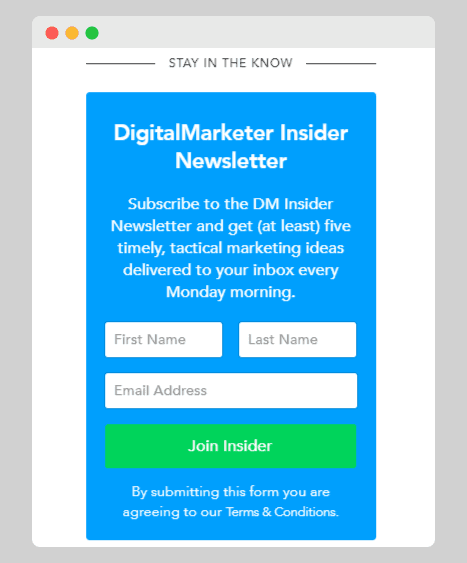
An Interesting Fact
DigitalMarketer doesn’t use any popup form to collect emails. Both their opt-in and lead magnet sign-up forms are put right on the page, and they rely on excellent copy and relevancy to lure visitors to their email list.The 4-Step Welcome Sequence That Turns Subscribers Into Buyers
I can’t stress enough the importance of welcome sequences. According to Campaign Monitor, it is one of the most effective triggered emails regardless of the industry. In 2014, the DigitalMarketer welcome sequence looked like this.- First email: "Welcome to DigitalMarketer! Here's where to start..."
- Second email: "You're part of our family. Now let's become friends."
- Third email: "I keep my promise... ".
- Fourth email: "Get my entire marketing library for $1?"
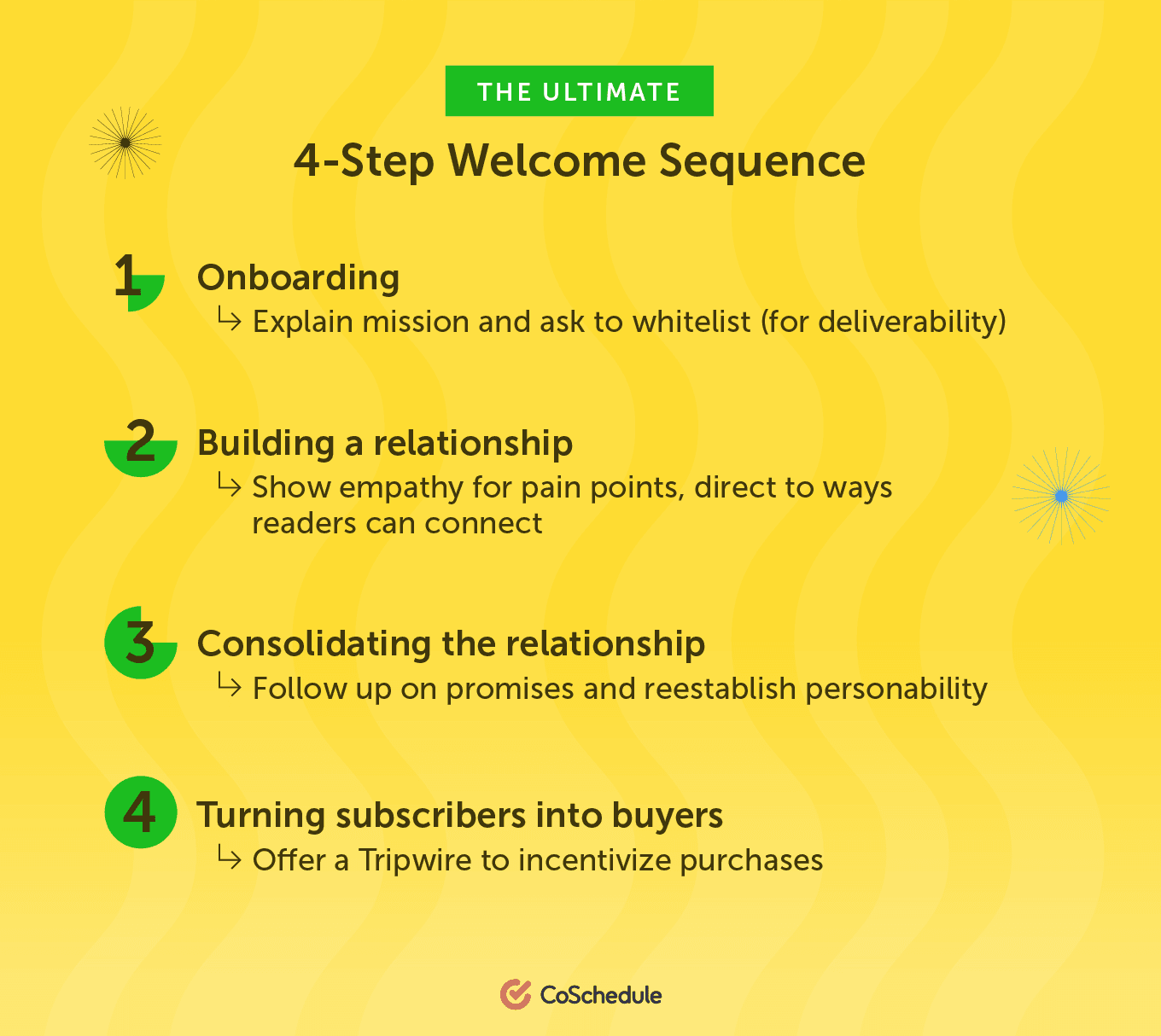
1. Onboarding
The first email in the sequence is designed to explain the company's mission. It also prepares recipients for further emails and asks them to whitelist their email addresses not to be considered spam. It also does a great job of introducing Ryan Deiss, who is the face of DigitalMarketer, and sending the email on his behalf. This is important because more than 42 percent of Americans claim to open an email based on the sender’s name.
It also does a great job of introducing Ryan Deiss, who is the face of DigitalMarketer, and sending the email on his behalf. This is important because more than 42 percent of Americans claim to open an email based on the sender’s name.
2. Building a Relationship
After introducing himself in the first email, Ryan Deiss is now back trying to create a relationship between himself and the subscribers. He uses empathy to put readers at ease and reassure them that whatever they are going through, they're not alone.
He uses empathy to put readers at ease and reassure them that whatever they are going through, they're not alone.
3. Consolidating the Relationship
Don't take my word for it. I'm not saying you can build a relationship by sending a single email. But there are psychological tricks you can use to build trust with your audience. In this 3rd email, Ryan Deiss consolidates his relationship with his audience by doing two things: keeping his promises and showing credibility.
In this 3rd email, Ryan Deiss consolidates his relationship with his audience by doing two things: keeping his promises and showing credibility.
Keeping your promises
Ryan promised to send recipients the most popular DigitalMarketer blog post. So he kept his promise by sending the link. Why is this important? Well, keep in mind that the #1 surefire way to disengage your audience is to overpromise and underdeliver. If you promise Seth Godin, make sure you can deliver Seth. Otherwise, your relationship will get off on the wrong foot, and you'll have a hard time regaining your audience's trust.Demonstrating credibility
By introducing the DigitalMarketer team and showing a photo of the DigitalMarketer team, Ryan Deiss does a great job building credibility. The recipient who sees the picture now knows that DigitalMarketer is legit, and that picture increases the company’s perceived value. On the other hand, the image keeps the readers engaged. Research shows that visuals increase a person's willingness to read content by 80%.4. Turning Subscribers into buyers Using a Tripwire
In this 4th email, as you can see, Ryan offers subscribers to purchase a DigitalMarketer product for a flat fee of $10. This strategy is called tripwire marketing.
Tripwire marketing is the act of offering prospects an inexpensive product with the intention of selling them more expensive products later.
The psychology behind this strategy is that once a prospect becomes a customer, they are more likely to become one again.
So after customers purchase the tripwire offer, the email list is usually segmented into separate lists, which allows for more targeted marketing campaigns.
This strategy also works because people like promotional emails. For instance, 68% of millennials declared that promotional emails have factored in on their purchase decisions.
This strategy is called tripwire marketing.
Tripwire marketing is the act of offering prospects an inexpensive product with the intention of selling them more expensive products later.
The psychology behind this strategy is that once a prospect becomes a customer, they are more likely to become one again.
So after customers purchase the tripwire offer, the email list is usually segmented into separate lists, which allows for more targeted marketing campaigns.
This strategy also works because people like promotional emails. For instance, 68% of millennials declared that promotional emails have factored in on their purchase decisions.
68% of millennials declared that promotional emails have factored in on their purchase decisions. Via @CoSchedule
Click To TweetThe Types Of Subject Lines DigitalMarketer Uses to Make Over 39M In Sales
DigitalMarketer does not just teach email marketing. The company itself is living proof that email marketing works. Email is the Swiss Army Knife they use to sell their services and promote their different events. Case in point, using email marketing, they were able to promote their Traffic & Conversion event and gather up to 4,500 attendees in just eight years. That is because when it comes to crafting subject lines that get emails open, DigitalMarketer brings out the A-game. After analyzing a great deal of the emails the company sends, here are seven types of subject lines they use.1. Blind or Curiosity
 This is a psychological trick used by DigitalMarketer and it is a surefire way to get the recipient to engage with the email content.
This type of subject line is written in such a way that it first piques the reader’s interest and then leaves them wanting more. It's all about enticing the recipient to want to discover more after reading the email subject line. In this case, you might be wondering, “But what is the lifeblood of my business?”
This is a psychological trick used by DigitalMarketer and it is a surefire way to get the recipient to engage with the email content.
This type of subject line is written in such a way that it first piques the reader’s interest and then leaves them wanting more. It's all about enticing the recipient to want to discover more after reading the email subject line. In this case, you might be wondering, “But what is the lifeblood of my business?”
2. Direct or Benefit
 Sometimes it's best to say what you have to offer simply. DigitalMarketer employs this in their subject line very often. They keep it simple, clear, and straight to the point. And as you read it, you get a sense of what’s in it for you.
Sometimes it's best to say what you have to offer simply. DigitalMarketer employs this in their subject line very often. They keep it simple, clear, and straight to the point. And as you read it, you get a sense of what’s in it for you.
3. Urgency or Scarcity
 This type of subject line works well because of the human fear of missing out (FOMO). It creates a sense of urgency and scarcity of the offer, so recipients feel they must act quickly not to miss the offer.
This type of subject line works well because of the human fear of missing out (FOMO). It creates a sense of urgency and scarcity of the offer, so recipients feel they must act quickly not to miss the offer.
4. Proof/Results or Credibility
 This is using stories of their customers to tweak their subject lines to highlight benefits in recipients’ eyes. It gives an idea of a success that readers can replicate to get results and share it in the subject line of their emails.
This is using stories of their customers to tweak their subject lines to highlight benefits in recipients’ eyes. It gives an idea of a success that readers can replicate to get results and share it in the subject line of their emails.
5. Self-Interest
 All the recipient wants is to feel valued and essential to the company. Self-interest-based subject lines are designed to elicit a personal benefit for the recipient.
In these types of subject lines, DigitalMarketer simply emphasizes the recipient’s interest and gives them a clue about the content of the email.
All the recipient wants is to feel valued and essential to the company. Self-interest-based subject lines are designed to elicit a personal benefit for the recipient.
In these types of subject lines, DigitalMarketer simply emphasizes the recipient’s interest and gives them a clue about the content of the email.
6. Question
 Using questions in subject lines helps businesses spark recipients' interest, and DigitalMarketer does an even better job of combining subject line questions with other tactics to pique recipients' curiosity.
Using questions in subject lines helps businesses spark recipients' interest, and DigitalMarketer does an even better job of combining subject line questions with other tactics to pique recipients' curiosity.
7. Authority
 It's kind of like influencer marketing. Authority is a powerful engagement driver for email subject lines. DigitalMarketer operates in the digital marketing education niche, so their approach promises valuable information from an authoritative marketer in the subject line.
It's kind of like influencer marketing. Authority is a powerful engagement driver for email subject lines. DigitalMarketer operates in the digital marketing education niche, so their approach promises valuable information from an authoritative marketer in the subject line.
Bonus: Use Emojis In Your Subject Lines
Emojis are known for conveying fun in an email subject line. But that’s not all. Using emojis will help communicate essential emotion in your email subject line. This is an ideal way of triggering an emotion or saying something that words cannot portray.
This is an ideal way of triggering an emotion or saying something that words cannot portray.
The 2 Types Of Copywriting Formulas To Boost Your Clickthrough And Conversion Rates
1. AIDA
Developed in 1898 by Elias St. Elmo Lewis, AIDA stands for Attention, Interest, Desire, and Action, in that linear hierarchy. As seasoned marketers, DigitalMarketer copywriters use this formula to write email copy. Here is a sneak peek of how they use AIDA in each of their emails.
- Attention: This step is all about getting the reader's attention and getting them to read on. In the above email, Ryan Deiss uses an open-ended question to grab the reader's attention. This question prompts you to learn more and read on to discover your "founder type.”
- Interest: At this stage, the focus is on the point of interest that keeps the reader reading. In the case of DigitalMarketer’s email, it is the diagram used to engage the reader. Not only does the diagram answer the question at the top, but it also provides very little information about the types of founders. As a result, the reader is prompted to read on before figuring it out.
- Desire: At this stage, an advantage or something is put forward that arouses desire and holds interest. As you can see, DigitalMarketer's email explains why it is essential (benefit) to know the "founder type" that you are.
- Action: Here, you encourage the reader to interact with the call to action and get closer to the desired prize or claim it. In our case, the reader is called to click on a link and participate in a faux survey.
2. PAS
PAS, which stands for Problem, Agitate, Solve, takes a similar approach to AIDA, only this approach is problem-driven. You identify the problem to hook the reader, agitate the problem and offer the solution. Here's how DigitalMarketer uses PAS to persuade readers to take action.
- Problem: At this point, you need to state the problem. In the email above, DigitalMarketer describes the problem of LinkedIn advertising. If you are part of their audience, reading it, you feel like they are listening to the conversation going on in your head. And that's a fast track to trusting them.
- Agitate: Here, it's all about stirring things up. In DigitalMarketer's email, as you can see, they make the conversation painful by making it more emotional. As you read it, you will feel the regret that you are not taking advantage of LinkedIn right now.
- Solve: At this point, you need to make it clear that it's not all black and white. And this is where you offer a solution. This is where Ryan Deiss pulls out the solution like a sleeve trick and paints it like the balm the reader has been looking for.

Bonus: Click triggers
AIDA and PAS are just two of the psychological tricks DigitalMarketer uses to make their email marketing successful. For example, they also use click triggers that do nothing but boost conversions. Here are some examples of click triggers that DigitalMarketer uses, and you can use them too.- Ask a benefit-centric question: How do we write high-converting follow-up emails?
- Link the evidence to the product: The machine increases conversion rates by 34%. See how here: [LINK]
- Show them their "new me": With The Machine, you'll know how to create an email marketing strategy that closes crazy deals.
- Storytelling: In our promotion of The Machine, Ryan Deiss tells the story of a time he made a huge mistake by failing to save money to pay a 6-figure tax bill.
The Segmentation Tactic That Keep Campaigns Successful
One of the elements that explain the success of DigitalMarketer's email marketing strategy is the way they segment their list. If you’ve been in marketing for at least 3 minutes, you know that not all subscribers are the same. And that, DigitalMarketer knows very well. That's why they are earnest about segmentation. Remember the email where Ryan Deiss asks readers to click on a link to find out what kind of founder they are? He uses this faux survey tactic to determine if you're a business owner, marketer, etc. But also to find out what it is like you're struggling with marketing-wise.
He uses this faux survey tactic to determine if you're a business owner, marketer, etc. But also to find out what it is like you're struggling with marketing-wise.
 Then, he uses these insights to segment the list and sends more targeted emails.
Then, he uses these insights to segment the list and sends more targeted emails.
 But DigitalMarketer's segmentation attempts don't stop there.
Take, for example, the tripwire mentioned above. It is used to segment the list into those ready to buy and those not prepared to buy.
When you have such a segmented list, at least you know what kind of message to send to each segment. It goes without saying that it helps you make the most of your list in the short and long term.
But DigitalMarketer's segmentation attempts don't stop there.
Take, for example, the tripwire mentioned above. It is used to segment the list into those ready to buy and those not prepared to buy.
When you have such a segmented list, at least you know what kind of message to send to each segment. It goes without saying that it helps you make the most of your list in the short and long term.
Recap
DigitalMarketer has used the above email marketing tactics to grow over the years and become one of the most successful companies that others can learn from. If you’ve ever wanted to make the most of email marketing, here are some things to remember:- Build an email list (and keep growing it).
- Make your subscribers love you right off the bat with a powerful onboarding sequence.
- Sort them into different segments based on their unique needs and specificity.
- Connect and build a relationship with them at a deeper level (like no other company does).
- Design excellent email copy they will love.
- Keep feeding them with valuable information and resources they enjoy.
- Whether they buy from you or not, make sure you keep the relationship alive.


